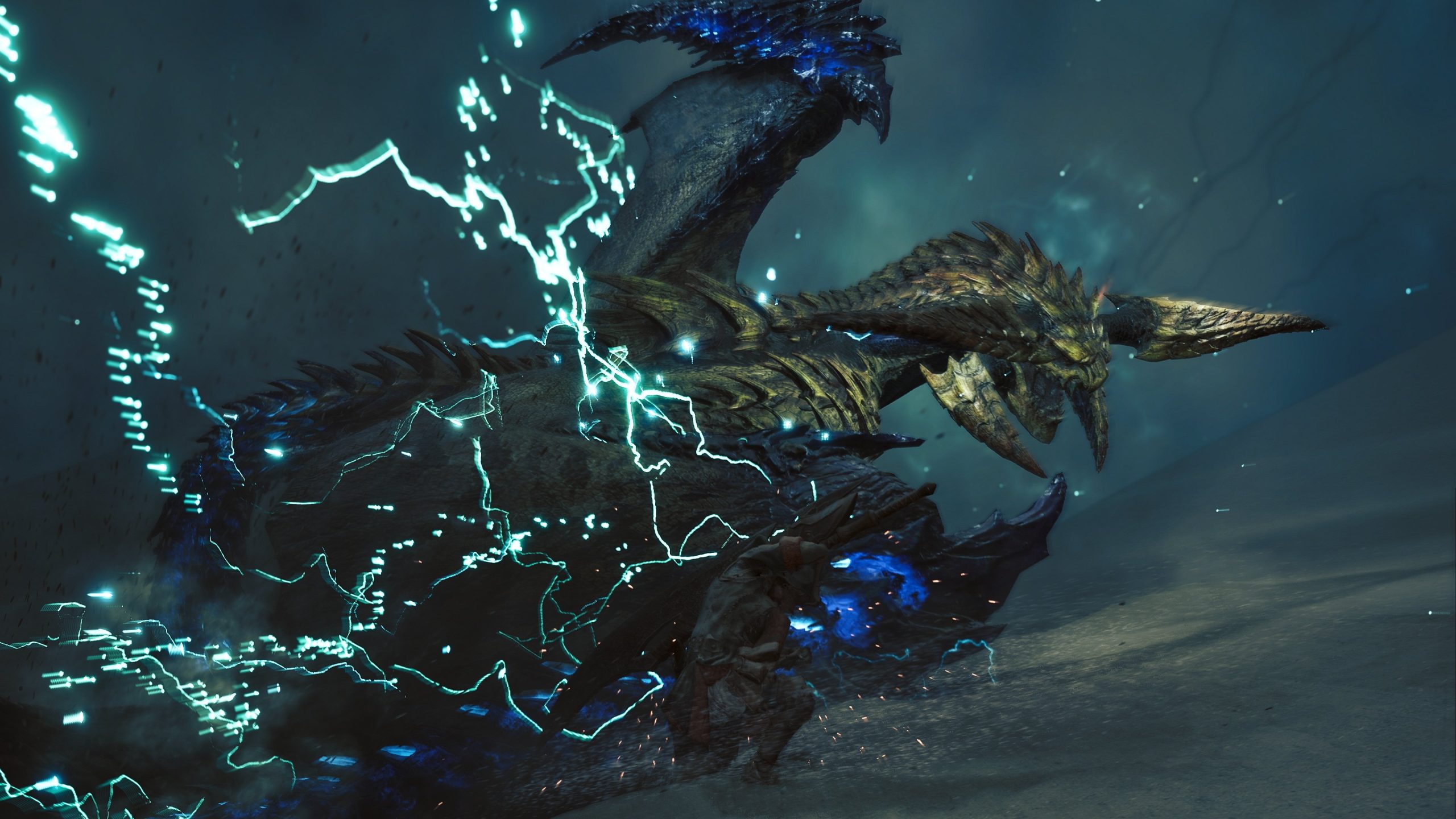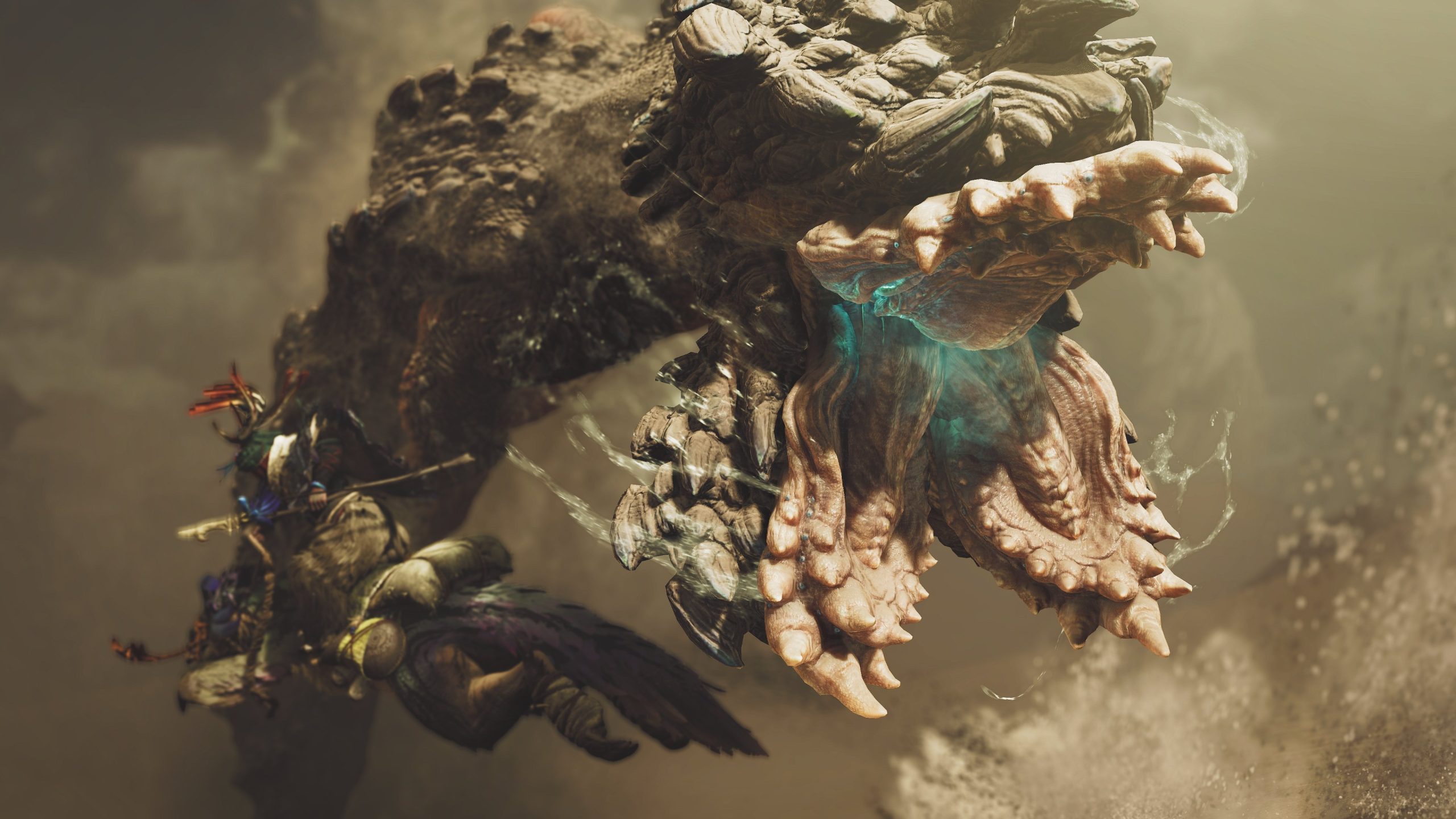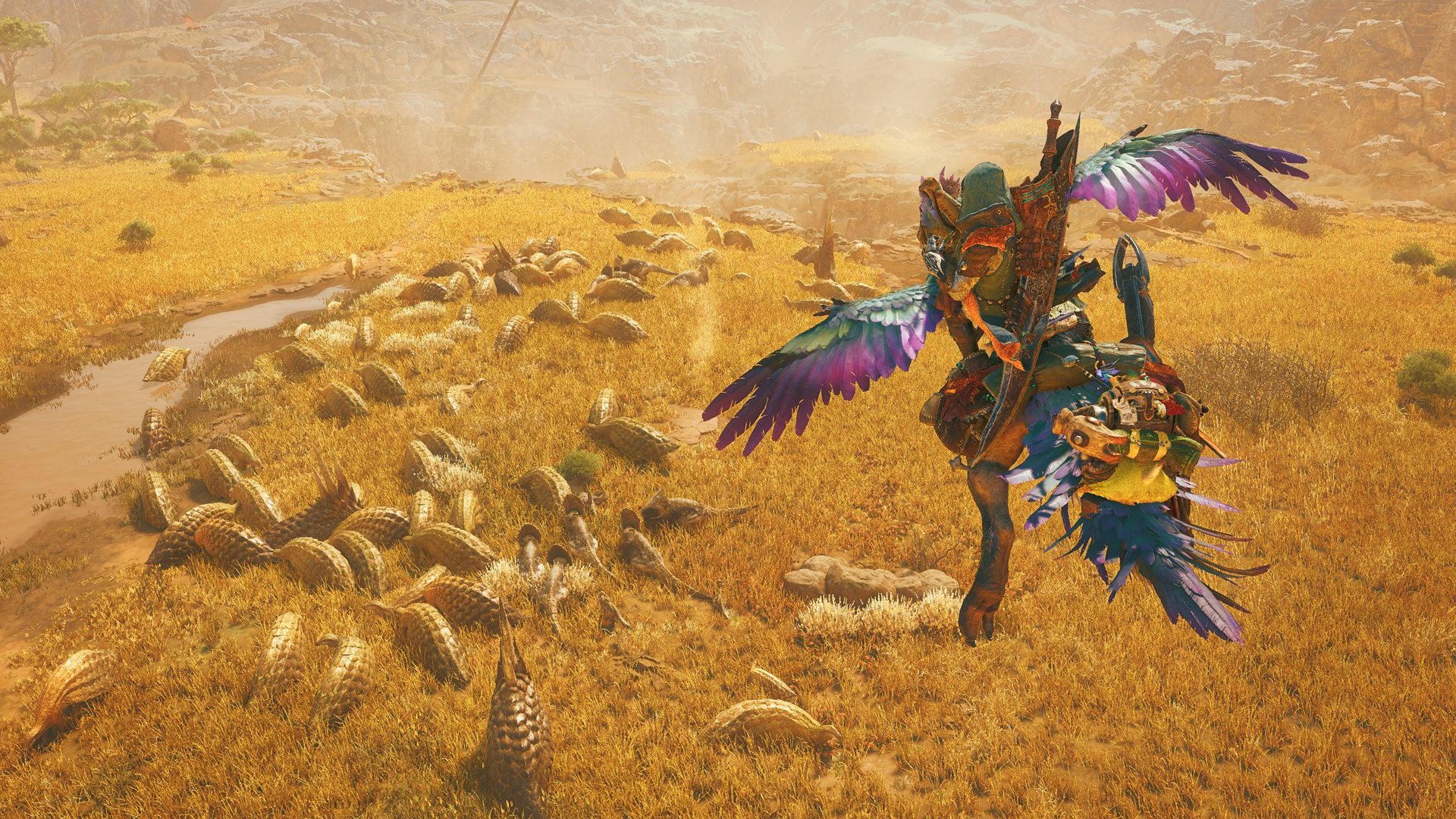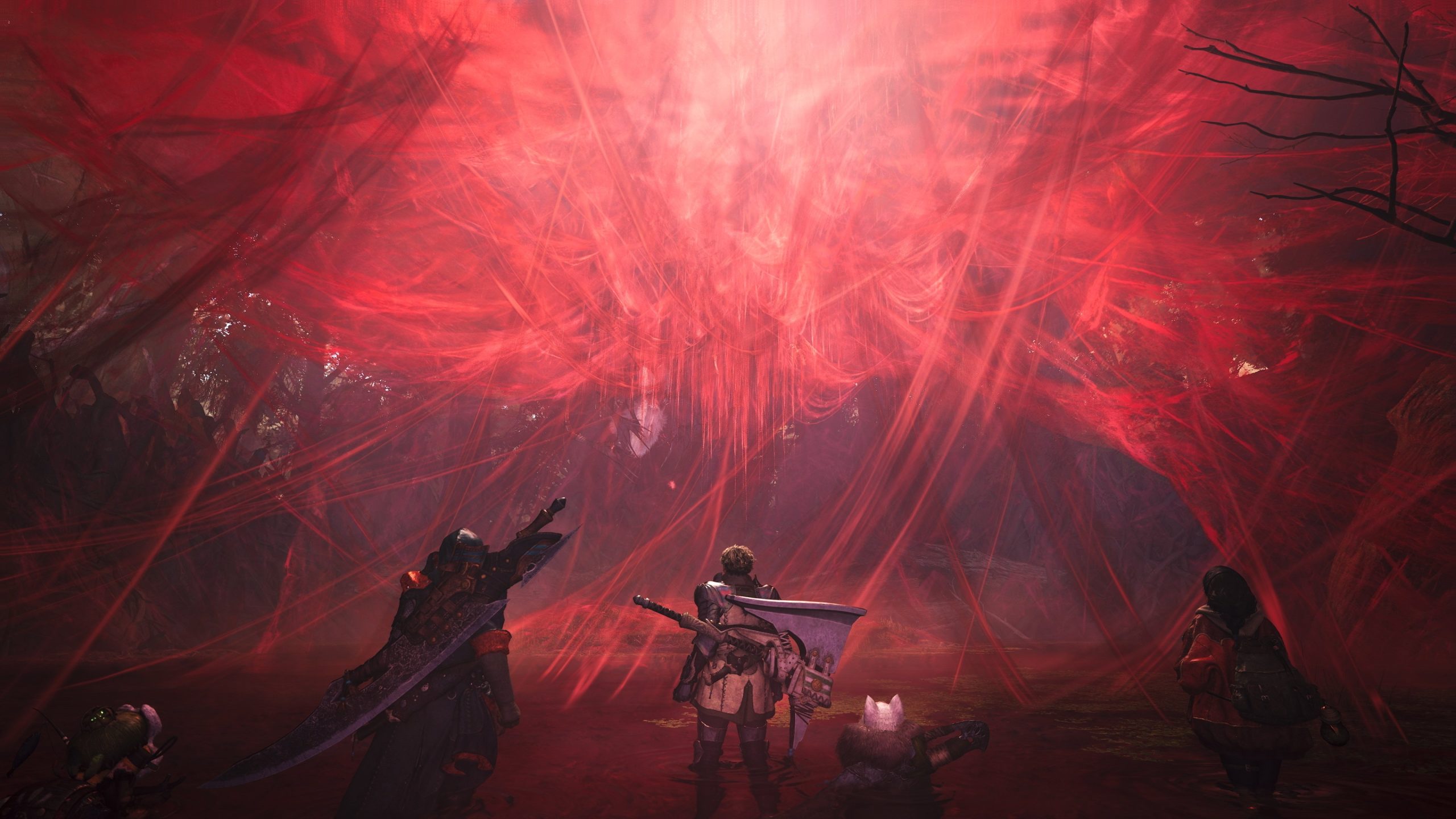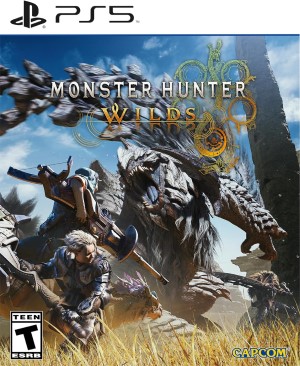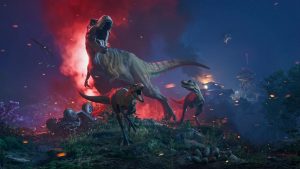
For me, Monster Hunter shares one sentiment – and only one – with Destiny: I hate it, and it’s my favorite franchise (or at least one of them). That’s reflected in all the time spent in Monster Hunter World, dragging myself through multiple Siege quests and Fatalis attempts. Swearing I would never come back, not even to play Rise, and yet, returning anyway, all the way to Sunbreak and its Affliction-riddled madness, cussing and raging while simultaneously seeking out the next challenge. Just when I swear I’m out, and the monster roars, trips, and instant deaths are a horrible memory, it pulls me back in.
Such is the case with Monster Hunter Wilds, but it caught my favor sooner due to how much it felt like a successor to World. All the Switch Skills and smaller maps of Rise were fine and whatnot, but World is where I – and many other people – really got into the franchise and discovered its magic.
Monster Hunter Wilds isn’t exactly a sequel or a successor to World. Calling it an enhanced version is also odd for reasons I’ll get into. Nevertheless, and above all else, it’s a pretty good Monster Hunter game, even if the signature loop of “Hunt monsters, get materials to craft better equipment to hunt tougher monsters” may work out differently for some.
"Even with this set-up, the core plot of Monster Hunter Wilds follows many familiar tropes. The quest structure, at least during certain parts of the story, also got a little too rote at times."
Stop me if you’ve heard this before: The Guild ventures to unknown lands to investigate mysterious phenomena and encounters dangerous monsters. Sooner or later, they learn that things are much more complicated than they seem, investigating mysterious occurrences tied to seemingly legendary monsters. It’s a timeworn premise, but to my surprise, Monster Hunter Wilds plays around with it in some interesting ways.
One of the main drivers of the plot is Nata, a young survivor discovered near the Forbidden Lands. His story of the White Wraith ultimately motivates an expedition led by you and a new Handler into this new frontier. While learning more about the White Wraith is key, the narrative dabbles into the overall ecosystem and its constant shifts, extolling on the balance of humanity and nature and the Hunters’ role beyond turning a monster that looks at us funny into a nice hat. I also liked Nata’s character development – it’s a gradual shift that feels earned, with his journey of seeing the wider world, and moving on from his trauma meshing quite well.
The other characters didn’t quite resonate as much, though Gemma the blacksmith does have some notable layers to her backstory. Olivia, another Hunter that can back the player up during Hunts, and Erik, a curious yet incautious biologist, are also intriguing during their appearances, but only just. Of course, you also meet with different villagers and learn more about their culture and place in the Forbidden Lands. Again, nothing too compelling in terms of characterization, though I found the Wudwuds of the Scarlet Forest charming.
Even with this set-up, the core plot of Monster Hunter Wilds follows many familiar tropes. The quest structure, at least during certain parts of the story, also got a little too rote at times. I can appreciate the reduced reliance on the gimmicky set pieces of World and Rise – even some of the chase sequences don’t feel hamfisted or overstay their welcome.
However, the number of times I would slowly canter through a locale conversing with other characters felt a bit excessive. And while the cutscenes are impressive, setting the tone of many fights in a hyped manner, the dialogue choices are superfluous and ultimately inconsequential.
"Of course, the main appeal of Monster Hunter Wilds is the hunting of monsters and this is truly where the experience shines. I think this may be the most refined and enjoyable combat in the series to date."
Things improve as you progress further and are unleashed upon the Forbidden Lands. For all my hang-ups with the story, the actual environments are pleasing to explore. The plains of Windward Plains are nice and flat, but other regions offer dunes with the potential threat of a Balahara trapping you in a whirlpool, sending you into its lair. You also encounter rockier expanses and an arena seemingly built for Rey Dau, one of the new Wyverns, to excel.
Then there’s the Scarlet Forest, which has shades of World’s Ancient Forest, but with more open spaces and water bodies, not to mention a conveniently crafted overhead route for your mount to traverse. Some of the monsters, like Uth Duna, will also use the more water-heavy sections against you in creative ways. Further areas are similarly compelling to explore and boast impressive attention to detail with their endemic life, changing weather, and art direction. As is tradition, looking for ways to leverage the environment in creative ways, whether it’s hanging rocks overhead or vine traps, is vital.
As for the dynamic weather and day/night cycle, I like the cycling periods of Fallow, Inclemency and Plenty, and how they influence different occurrences on the map, like an outbreak of certain flora and fauna or even environmental hazards. Phenomena like the Sandtide can also have an impact on hunts, with thunder raining down from the sky, and hitting monsters. It’s not the most game-changing aspect, but offers an additional wrinkle without feeling too oppressive.
Of course, the main appeal of Monster Hunter Wilds is the hunting of monsters and this is truly where the experience shines. I think this may be the most refined and enjoyable combat in the series to date. While I didn’t go hands-on with all 14 weapon types, focusing instead on the Sword and Shield, it felt like a dream.
Perfect Guard is so satisfying to initiate (if a little too forgiving at times) while the counter-hits have some serious oomph, yet even the regular combos are blissfully responsive. The hit-stop changes over the beta are also very much apparent – plunging the sword into a monster with the Charged Chop is more visceral, reinforcing its devastating nature.
World and Rise both had their share of new combat mechanics like Clutch Claw/Tenderize and Wirebug/Switch Skills/Wyvern Riding. Wilds introduces two new systems – wounds and Focus Mode. As you attack a monster, wounds will appear on its body. Attacking and destroying these will deal more damage and some stun on top of providing materials. However, if you activate Focus Mode, you can initiate a Focus Strike, a special attack that destroys the wound more sensationally and deals more damage.
"As for monsters, Wilds delivers an eclectic bunch of returning threats and newcomers. Each feels like it fits naturally into the respective ecosystems and looks great overall, from Chatacabra and its uncomfortably moist skin to Quematrice and its dazzling flames."
The tradeoff is that a destroyed wound can’t be opened up again, encouraging you to focus on other parts of the body. This combines so well with the focus on breaking monster parts for materials that I’m surprised it’s taken this long to turn it into a regular mechanic, even if it bears a slight resemblance to the Anomaly Cores from Sunbreak’s Afflicted Monsters. Don’t worry, though – you’ll find a system similar to the latter as you progress.
When you combine everything – the environments and their dynamic weather conditions, the satisfying feel of combat, wounds, and Focus Strikes – it’s an honestly addictive combat experience. Even some of the more annoying aspects of a Monster Hunter experience, like monsters running away, don’t feel nearly as egregious as past entries. This isn’t to say that some of the flyers won’t venture far after taking a few hits, but it felt less common than World.
As for monsters, Wilds delivers an eclectic bunch of returning threats and newcomers. Each feels like it fits naturally into the respective ecosystems and looks great overall, from Chatacabra and its uncomfortably moist skin to Quematrice and its dazzling flames. Ajarakan reminded me a bit of Rajang but with some interesting twists that forced some changes to my usual counter-hit playstyle. There’s a solid mix of up-close brawlers, ranged combatants, hit-and-run attackers, and others that diversify their tactics among these to keep the combat feeling mostly fresh.
I say “mostly” because as far as difficulty goes, Monster Hunter Wilds is probably the series’ easiest yet. Some context: I’ve spent hundreds of hours in World + Iceborne and probably one hundred hours in Rise + Sunbreak. These may seem like impressive figures, but I’m far behind those who have been on these games for years at a time, let alone feeling their toughest challenges (you’ll notice I said Fatalis “attempts” earlier, not “kills”).
Long story short, I’m no expert, but Wilds felt barely challenging through much of Low Rank. I would run with the same armor and weapon for multiple fights in a row, barely upgrading my defense. Several fights shockingly lasted for mere minutes at a time.
When it felt like I reached what could be considered a difficulty spike, I would usually craft a higher rarity armor and cobble things together, which more or less continued into High Rank. Even then, I never felt the urge to grind out a single set or min-max my gear. Fights barely crossed the 20-minute mark, even when it was clear that monsters were hitting a little harder than usual.
"Regarding the endgame, hunting High Rank and Tempered Monsters will award Decorations, and you can earn an embarrassing amount with multi-target Hunts."
Your mileage may vary, but this isn’t just a humble brag. The lack of challenge for a good chunk of the experience felt like it messed with my sense of the core loop. On the one hand, it felt kind of liberating to not have to worry about these things and just venture out into the wilds, slaughtering monsters left and right while gathering resources.
However, once I had my fill, I would return to the story, if only to unlock many core features and find some sense of a challenge. The story has always been half-jokingly referred to as the tutorial in past Monster Hunter titles. In Wilds, it feels like just that, almost to an insulting degree (personally, of course).
Things do slightly improve when you reach the so-called endgame, especially as Tempered Monsters enter the picture. By that point, I decided to invest in endgame armor and optimize some more, if only to avail of their quality-of-life features and slots. Even then, it felt like only two or three Tempered Monsters offered any real sense of danger and unpredictability. Beyond that, it didn’t feel like there was anything else to conquer.
Regarding the endgame, hunting High Rank and Tempered Monsters will award Decorations, and you can earn an embarrassing amount with multi-target Hunts. Decorations with multiple skills drop from Tempered hunts and feel like the true min-maxing experience. I’ll admit, gaining a Level 3 Decoration with three points in a main skill and one point in a crucial secondary skill feels good.
You also have Artian Weapons, which can be crafted from Artian parts, also obtained from Tempered Monsters. The catch is that each part must be of the corresponding rarity to forge the weapon. While you can mix and match parts depending on your desired Affinity and Attack, not having two parts of the same element or status ailment can result in a raw damage weapon.
At a glance, this may seem like an adaptation of the Safi’jiiva crafting and awakening system from Iceborne, though a bit more limiting. It’s far from a downside, though, since Artian Weapons offer a means to create some strong elemental or status weapons as you spend more time hunting specific monsters.
"Even with all of this in mind, and the ability to save potential targets as Investigations to hunt later, Wilds’ endgame is lacking. Heck, even the new arena, the Wounded Hollow, felt like a shadow of World’s Arena."
They also don’t replace the traditional weapon crafting system, especially since every weapon now has an intrinsic skill. So while you could rely on that Artian Weapon and slot in Decorations of your liking, maybe there’s a weapon with a skill that could work well with your build (even at the cost of higher-level Decoration slots).
Speaking of build-crafting, Wilds makes a rather drastic change. Weapons can have their own intrinsic skills and slot in certain Decoration types. However, those same types cannot be equipped on your armor, forcing you to really pick and choose which ones are worth taking.
This is initially limiting, no doubt, but as time went on, I began to appreciate the experimentation, and opting for quality-of-life Decorations, whether they enhanced my playstyle or simply felt good to have. Whether it’s due to the overall difficulty and balance concerns or simply to combat players going for the full spread of familiar damage skills once more is hard to say, but it works.
Even with all of this in mind, and the ability to save potential targets as Investigations to hunt later, Wilds’ endgame is lacking. Heck, even the new arena, the Wounded Hollow, felt like a shadow of World’s Arena. To be fair, I didn’t have access to any Event Quests, so the development team could likely deliver more stringent conditions and tougher targets post-launch. Still, it’s hard not to feel a little whelmed.
I don’t know if it’s because this is the beginning of yet another fresh slate, where Wilds is a new platform that Capcom will build and iterate upon, and then add some real end-game content with the inevitable expansion. Regardless, in terms of difficulty and diversity, the current end-game just isn’t enough for me.
I could bemoan the lack of other features from previous titles, like the canteen and the cats with their darling animations. However, Monster Hunter Wilds offers a rich array of quality-of-life improvements and features. Pop-up camps, the ability to cook meals anywhere (though the ones with the most buffs come from feast invites), not having to fully complete the animation for gaining weapon sharpness, the Seikret (even if it’s auto-move can get a little wonky at times), the aforementioned Investigations, the radial menu that automatically selects the best healing and status curing items – they all fit in perfectly.
"It’s not the be-all, end-all Monster Hunter, but while there’s no shortage of things to improve on, Monster Hunter Wilds is an enjoyable action RPG with some great new additions to the formula, and I’m intrigued to see how it’s built upon in the future."
As for multiplayer, I dabbled a bit with co-op hunts, usually responding to SOS flares for people who already had AI Support Hunters in their party. I couldn’t delve into the nitty gritty of lobbies or inviting friends, so time will tell how these perform at launch. Nevertheless, barring a few instances of lag, these hunts felt pretty good, though it feels like they further trivialize the difficulty on all but the toughest Tempered targets.
I mentioned the art direction and appreciation for Wilds’ art direction earlier, and that extends to the sound design and music, which are top-tier as always. Unfortunately, the technical aspects of the visuals aren’t, at least on the base PS5. Playing on Balanced Mode with 120 Hz mode enabled and the Frame Cap off resulted in a decent mix of resolution and frame rate, even if it meant sacrificing 60 FPS.
The results were decent enough, though distant objects in larger environments suffer in their image quality. Asset loading issues would also rarely occur, such as having the environmental cue for a falling boulder…and it was invisible.
The image quality in Performance Mode takes a bigger hit while pop-in is more apparent and some close-up textures can look iffy. On the bright side, it’s mostly locked to 60 FPS, so if you can stomach everything else, it may just be the mode for you. If nothing else, it’s a major improvement over the beta with no sign of origami Rey Dau.
Despite my various complaints with Monster Hunter Wilds, I did have an enjoyable experience. It’s an ideal experience whether you want to hunt a few targets or spend hours grinding out Decorations and Artian Parts. It’s not the be-all, end-all Monster Hunter, but while there’s no shortage of things to improve on, Monster Hunter Wilds is an enjoyable action RPG with some great new additions to the formula, and I’m intrigued to see how it’s built upon in the future.
This game was reviewed on the PS5.
A fresh new world to explore with incredible monsters to fight and amazingly realized environments. Combat is the best it's ever been, with wounds and Focus Mode augmenting its core tenets. Numerous quality-of-life improvements lead to a more comfortable experience without taking away from the main gameplay loop. Intriguing storyline and character development. Solid performance overall. Decoration changes and new weapon options help refresh the build-crafting.
Image quality is still iffy, especially in Performance Mode. Lack of challenge throughout. The endgame feels sparse compared to previous entries. Story missions can feel a bit routine with the constant slow cantering. Dialogue choices feel unnecessary. A fresh slate, waiting for Capcom to build on it with more challenging content, may not be to everyone's taste.











